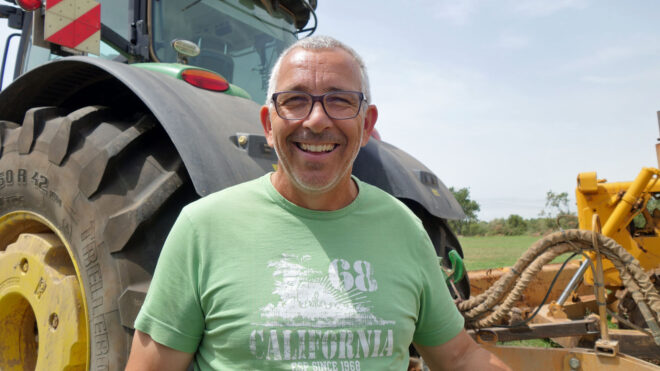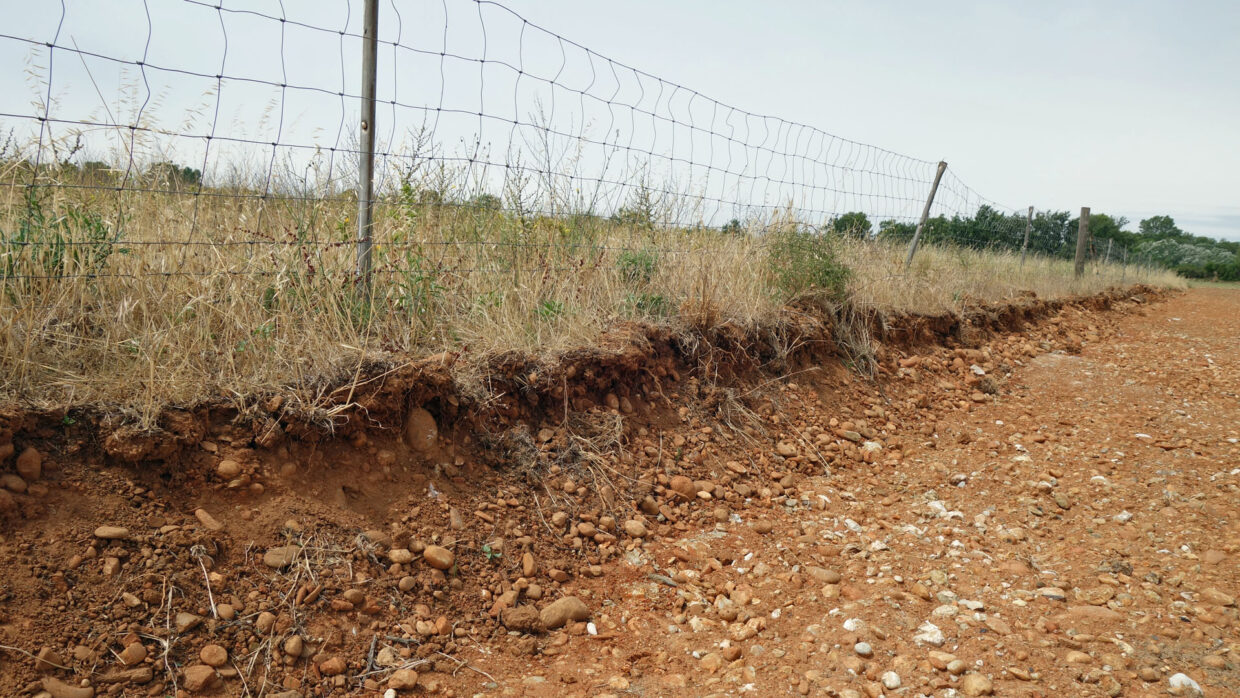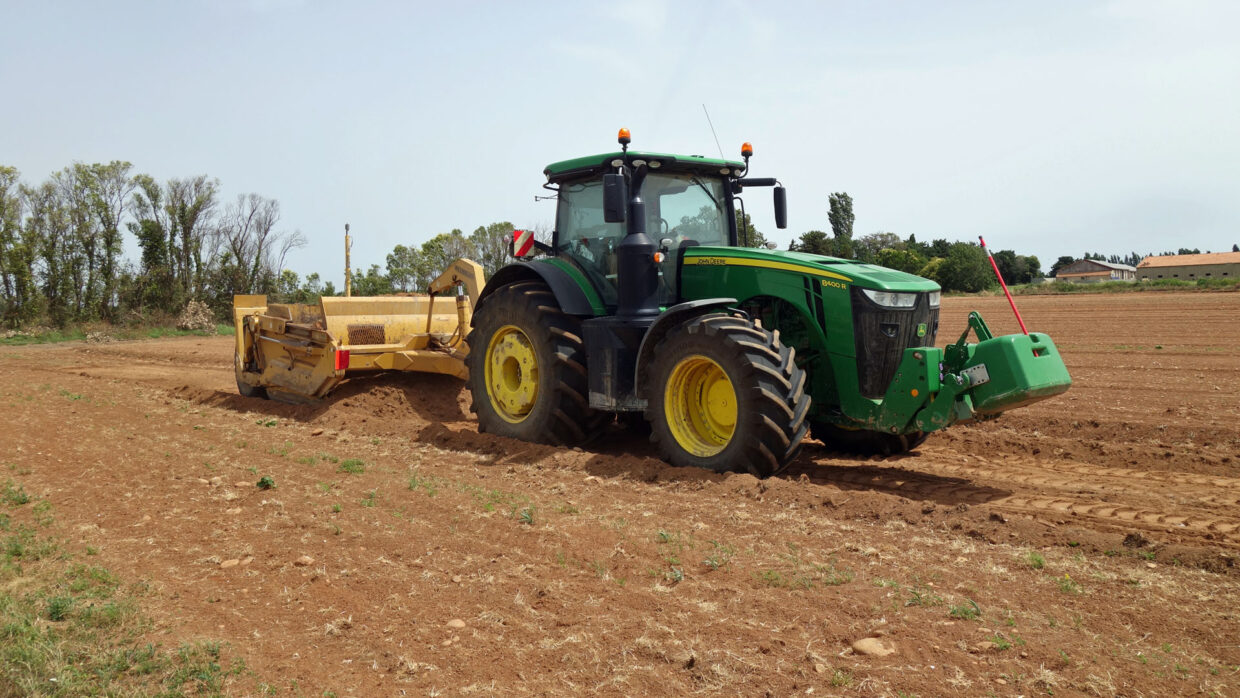Between the Camargue region and the city of Marseille extends the plain of La Crau, 52,000ha, including 12-13,000ha of meadows, irrigated by a network of canals. These plots are bordered by filioles (small irrigation canals), connected to the network, which are made to overflow by means of martelières (small sluices) which obstruct them. The submersion is gradual and lasts several hours; the volumes supplied in the order of 15,000 to 20,000m3/ha/year.

Olivier Tommasi, agricultural contractor in Lançon-Provence, in the Bouches-du-Rhône Department.
This water is needed to produce the famous Crau Hay, appreciated for its diversity and nutritional richness. “It is made up of a balance of grasses, legumes and other plants,” explains Olivier Tommasi. “The owners gather it in three cuts, pressed into cubic bales of 500kg each, and then graze it with sheep. “
Restoring an ideal degree of slope – 0.28%
After 40 to 50 years, complete restoration of the meadow is necessary. Its levelling for reseeding and the associated structural work (canals, drainage ditches, embankments) are the specialty of the Tommasi Company and its three drivers. “The problem in the La Crau plain is twofold: The availability of water in the Durance is reducing, and the labour force – to manually manage the water intake in the canals – is becoming scarce,” explains the entrepreneur. “Hence the importance of creating a level meadow with an ideal degree of slope – 0.28%, so that the water submerges the meadow by gravity, evenly and above all else quickly.”
To carry out this work, Mr Tommasi uses GPS and laser guides, as well as powerful tractors. After clearing the meadow of cover crop, his driver Adrien Noguès takes control of a John Deere 8400R, which arrived last year, pulling the American 4.5m-wide Reynolds heavy scraper.
Specific programming of the E23 transmission
“Upon delivery, the 8400R Powershift transmission was configured to act like a classic arable tractor,” recalls Mr Noguès. However, with the scraper attached, the traction effort was violent when starting: The standard transmission setting led to slow downshifts and jerky transmission. “I had to compensate by accelerating again. We had to figure out how to adjust the transmission, to better anticipate the traction forces,” he continues.

Adrien Noguès, 23 years old, has a farming background and a degree in Civil Engineering; he has been working as a driver with Olivier Tomassi for the past four years.
Mr Tommasi then consulted his colleague Pierre Douineau, from Divatte-sur-Loire (Loire-Atlantique), a well-known contractor in the field of earthwork scrapers, towed by John Deere tractors. “Remotely, Pierre guided us in making adjustments to the in-cabin console,” confirms Mr Tommasi. “We were able to reduce the transmission’s downshift anticipation rate from 20% to 14%. The tractor immediately became extremely efficient.” Mr Noguès reports, for example, that if the soil is soft, he can load 20t into the scraper in just 15m of travel.
Optimising ballast and tyre pressure
The John Deere 8400R is fitted with rear tyres sized IF 900/60R42 and front tyres IF 650/60R34. The IF (Improved Flexibility) technology of these tyres, in this case 900mm wide, seems to have been a good choice, because after 600 hours of operation, Mr Tommasi estimates that the power of the 400-horsepower tractor is efficiently transmitted, with fuel consumption maintained at 20 litres/hour.
To obtain this result, it was also necessary to optimise the vehicle’s ballast as well as the tyre pressure. The tractor weight was increased to its maximum, following extensive ballasting, particularly at the wheels. “Thanks to the follow-up by technicians from the tyre manufacturer Trelleborg, we were able to weigh the assembly – first empty, and then loaded with soil,” recalls the contractor. “It turned out that the optimum tyre pressure, in my case, was 1.8 bar for both front and rear wheels.”
Machinery Fleet
- 3 high-power John Deere tractors
- 2 scrapers Reynolds/Autec
- 2 Autec levelling blades
- 1 Razol forest cover crop disc harrow
- 1 Caterpillar bulldozer
- 1 articulated dumper
- 1 Amazone combo drill and 1 Nodet seed drill without coulters (meadows)
- 1 Amazone mounted sprayer
- 1 classic KV 4-body plough
Adam de Craponne (1526-1576), engineer to King Henry II, built a canal in 1557 at his own expense to bring the waters of the Durance River, laden with silt, to Salon-de-Provence, Eyguières, Istres and as far as Arles. This canal, which allowed irrigation of part of the once arid La Crau, is still in use today.




